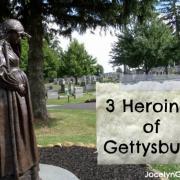3 Heroines of Gettysburg
[[{"type":"media", "view_mode":"media_large", "fid":"771", "attributes":{"class":"media-image alignright wp-image-891 size-full", "typeof":"foaf:Image", "style":"", "width":"125", "height":"193", "alt":"Widow cover 3 125"}}]]Both Hollywood and history books tell stories of valor from the battle of Gettysburg. But before the word "Gettysburg" was synonymous with battle, it was simply the name of a town where ordinary people lived—until extraordinary circumstances brought out strength and courage they did not know they possessed. These stories of resilience inspired me to write my novel Widow of Gettysburg, book 2 in the Heroines Behind the Lines series. Today I'd love to introduce you to just three real women of Gettysburg.
Sallie Myers
[[{"type":"media", "view_mode":"media_large", "fid":"1278", "attributes":{"class":"media-image wp-image-3260 size-medium", "typeof":"foaf:Image", "style":"", "width":"201", "height":"300", "alt":"Sallie Myers"}}]] Sallie Myers
Gettysburg school teacher Sallie Myers never could stand the sight of blood. But on the morning of July 2, 1863, the second day of battle, she could not ignore the desperate cries of the wounded lying in a church across the street. Kneeling by the first man inside the door of the church, Sallie asked what she could do for him. "Nothing," he replied. "I am going to die." Overcome with emotion, Sallie ran outside and wept. With great effort, she finally calmed herself and returned to the soldier, where she learned he was Sgt. Alexander Stewart of the 149th Pennsylvania Volunteers. With the surgeon's permission, she then had Sgt. Stewart brought to her home where she could better care for him. Though a bullet narrowly missed her where she sat fanning her patient, she refused to leave him for the safety of the cellar. After Sgt. Alexander died on July 6, 1863, Sallie took in eleven more soldiers while continuing to work in the make-shift hospitals of the town for weeks after the battle ended. "The sight of blood never again affected me and I was among the wounded and dying men day and night," Sallie recalled. "While the battle lasted and the town was in possession of the rebels, I went back and forth between my home and the hospitals without fear." The next summer, Sgt. Alexander's widow and his brother Henry came to visit her. From that meeting, Sallie and Henry began a relationship which resulted in their marriage in 1867.
Sadie Bushman
Nine-year-old Sadie Bushman was running to her grandparents' house for safety when the battle roared into action. I don't have a picture of Sadie, but I do know what nine looks like. My own daughter is currently the same age Sadie was when the following story took place.
[[{"type":"media", "view_mode":"media_large", "fid":"1279", "attributes":{"class":"media-image wp-image-3258", "typeof":"foaf:Image", "style":"", "width":"400", "height":"270", "alt":"This is my 9-year-old daughter looking on as my 6-year-old is being treated for his broken arm. "}}]] This is my 9-year-old daughter looking on as my 6-year-old is being treated for his broken arm. Little Sadie had a much different experience, as the youngest nurse in the Civil War.
Sadie tells the story in her own words: "There came a screech and a shell brushed my skirt as it went by. I staggered from the concussion of it and almost fell, when I was grasped by the arm and a man said pleasantly, ‘That was a close call. Come with me and hurry,' he added in a tone so commanding that I meekly followed. [That man was Dr. Benjamin F. Lyford, a surgeon in the Union army]. He led me to . . . an army corps hospital and then he put me to work. Wounded and dying men were then being carried to the place by the score. . . "As I reached the hospital tent a man with a leg shattered almost to a pulp was carried in. ‘Give him a drink of water while I cut off his leg' was the command I got. How I accomplished it I do not know but I stood there and assisted the surgeon all through the operation. I was in that field hospital all during the three days of the battle, climbing over heaps of bodies six and eight deep and always with the doctor helping him in his work. Then my father found me and took me home. Soon, the Christian and Sanitary Commissions set up a hospital on the scene of battle, and Sadie nursed there, too. "I was placed in charge of one of the wards and I was so small I had to climb up on the beds to attend to the sick and wounded men," she said. Having conquered her fear, Sadie served in that hospital nearly five months, though her father whipped her for nursing against his will.
Elizabeth Thorn
[[{"type":"media", "view_mode":"media_large", "fid":"1280", "attributes":{"class":"media-image size-full wp-image-3259", "typeof":"foaf:Image", "style":"", "width":"260", "height":"357", "alt":"Peter and Elizabeth Thorn"}}]] Peter and Elizabeth Thorn
Elizabeth her husband Peter were caretakers of Gettysburg's Evergreen Cemetery, and lived in the cemetery gatehouse with Elizabeth's parents and her three small sons. With Peter away as a soldier, Elizabeth tended the cemetery in his absence. She was six months pregnant in July 1863. Like most other Gettysburg women, she gave food and water to passing soldiers in both blue and grey before fleeing to safety during the battle. The Thorns returned to find their home severely damaged. But there was work to do. The cemetery president instructed her to bury the soldiers as fast as she could. The stench from the bloated corpses, both human and horse, was nauseating, but she and her father, aged 63, had little choice. The longer the bodies lay sweltering in the sun, the more of a health hazard they became. Elizabeth and her father buried 102 soldiers in Evergreen Cemetery. She was never compensated for her work in the aftermath of the battle, or for the damages to her home.
[[{"type":"media", "view_mode":"media_large", "fid":"1281", "attributes":{"class":"media-image wp-image-3179", "typeof":"foaf:Image", "style":"", "width":"500", "height":"375", "alt":"Monument to Elizabeth Thorn, the pregnant gravedigger, in Evergreen Cemetery."}}]] Monument to Elizabeth Thorn, the pregnant gravedigger, in Evergreen Cemetery.
These women, and so many others (Sarah Broadhead, Tillie Pierce, Hettie Shriver, etc.), did not ask to be heroines, but when war demanded it of them, they quietly filled the role. Their courage, sacrifice, and ability to love their enemies inspired Widow of Gettysburg, and I hope the book, in turn, inspires you. *Visiting Gettysburg soon? Don't miss these 9 Must-See Sites (Plus 5 Spots for R&R)!

